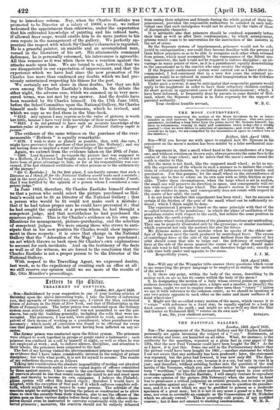THE MOON CONTROVERSY.
[The controversy respecting the motion of the Moon threatens to be as inter.
minable as that between the Bigendians and the Littlendians. Our own cure. spondence, including a long letter from the prime mover Mr. Symons himself, has been so voluminous, coming in daily and sometimes twice a.day—for a weekly journal !—that we were driven to selection of specimens; and even of those, after several are in type, we are compelled by the necessities of space to reselect two of the shortest.] His argument is, that a =all wheel fixed to the circumference of a large one, and without rotation on its own axis, always-presents the same face to the centre of the large wheel; and he infers that the moon's motion round the earth is similar to this.
But the moon is not fixed, like the supposed small wheel : so let us mo- dify the experiment of the wheels in such a manner as to imitate the condi- tions of celestial mechanism, by excluding all influences except inertia and gravitation. For this purpose, let the small wheel on the circumference of the large one be free to rotate on its own axis with as little friction as pos- sible. 'Under these circumstances when the large wheel is set in motion, the small one will preserve its direction in space, and consequently will ro- tate with respect to the large wheel. The moon's motion is the reverse of this : she rotates in space, and consequently does not rotate with respect to the centre of her orbit, the earth.
I do not know whether this experiment has been tried; but its success is certain if the friction of the axis of the small wheel can be sufficiently re- duced; which I think might be done.
The experiment I propose is based on the same principle with that of the so-called rotation of the pendulum ; in which the plane of oscillation of the pendulum rotates with respect to the earth, but retains the same position in space while the earth rotates.
All mere wheel-work illustrations of the planetary motions are misleading. They can be properly illustrated only by the gyroscope, or similar machines, which represent not only the motions but also the forces.
Mr. Symons makes another mistake -when he speaks of the oblate sur- face of the moon next the earth produced by centrifugal force. The excess of centrifugal force at the side of the moon farthest from the centre of her orbit should cause that side to bulge out : the deficiency of centrifugal force at the side of the moon nearest the centre of her orbit should make that side tend to fall towards the earth, and therefore bulge out exactly as a tide rises both under and opposite to the moon. Respectfully yours, S. I. M.


























 Previous page
Previous page